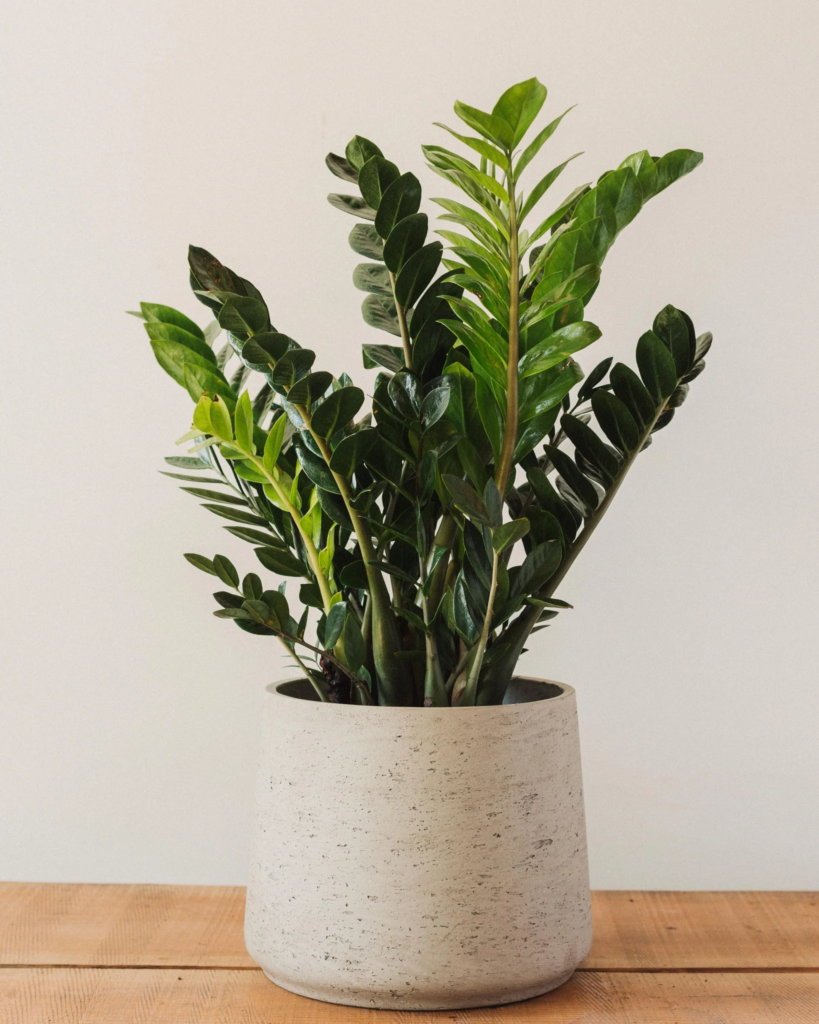We always feel better when we are around nature. When we transform our homes into mini natural havens, having a lot of plants can be beneficial. Plants not only calm our vision but also renew our minds, creating an environment that promotes our well-being.
Choosing the right houseplant for your space can be confusing, but a bit of research can go a long way. Having plants for decoration not only adds beauty but also offers various scientific benefits. Some plants have therapeutic properties, while others simply freshen the air in a room.
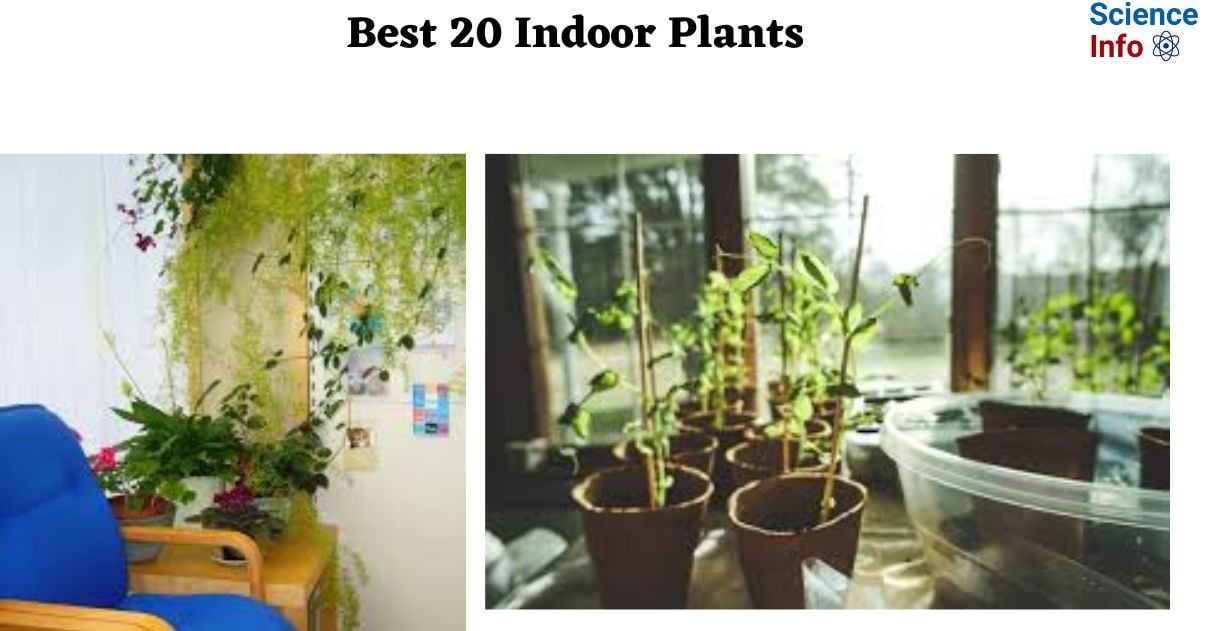
So let us delve into the best 20 indoor plants to have at your home with amazing values.
Interesting Science Videos
Best 20 Indoor Plants to have at your home
These are the top 20 lists of indoor plants:
- Aloe Vera
- Jade Plant
- Peace Lilly
- Pothos
- Spider Plant
- Boston Fern
- Philodendron
- String of Pearls
- Snake Plant
- Monstera
- Prayer Plant
- Zz Plant
- Anthurium
- Parlor Palm
- Lucky Bamboo
- Sweetheart Plant
- Pilea
- Watermelon peperomia
- Aglaonema
- Air Plant
Now, let us talk more about each plant listed above.
Aloe Vera (Aloe barbadensis)
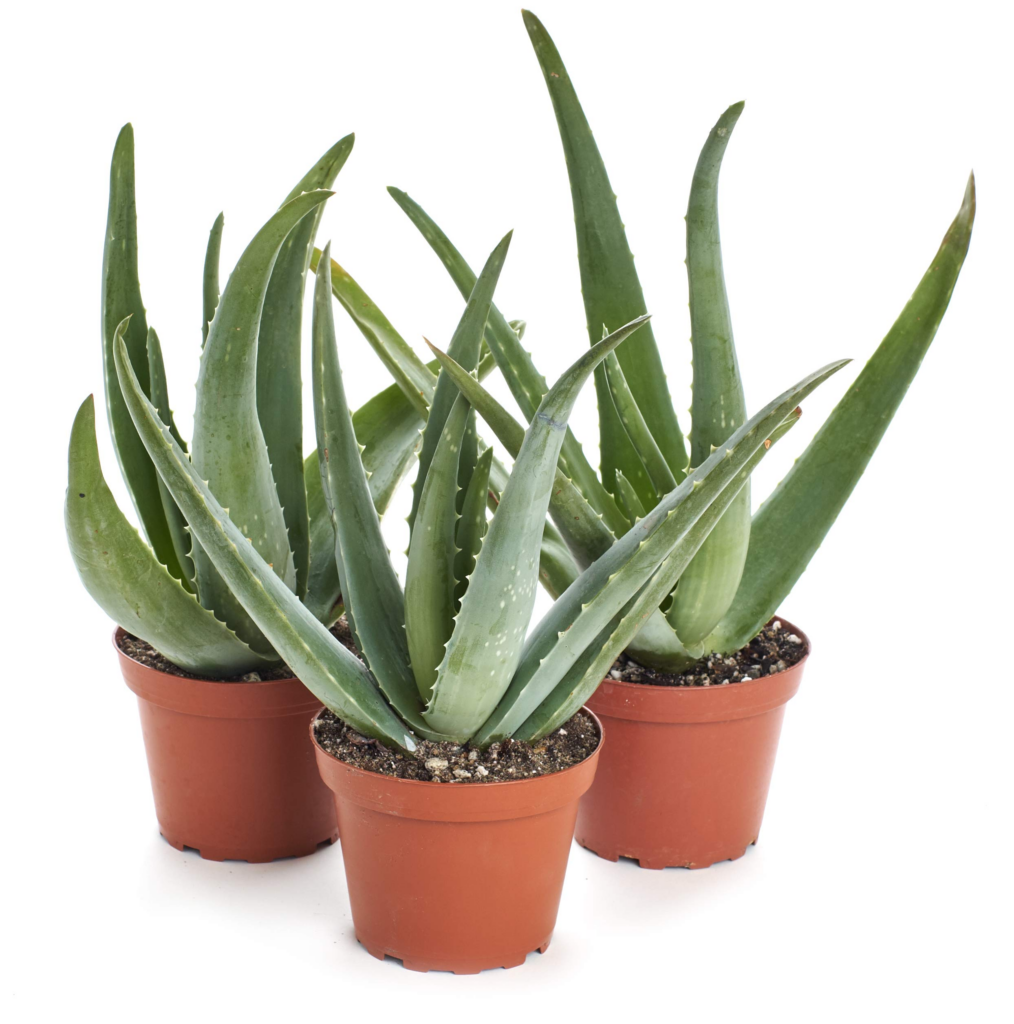
Aloe plants, scientifically known as Aloe barbadensis, grow in both parched deserts and luxuriant tropical jungles. They range in height from a few inches to more than 5 feet long and wide. Its unusual combination of beauty and utility makes it a popular option among houseplant enthusiasts.
One of the best air-purifying plants, it’s perfect for the kitchen, bathroom, or bedroom. Dermatologists have approved its many benefits, which include healing wounds, lessening sunburn sensitivity, and reducing acne and wrinkles. Try to keep your aloe plant happy by providing it with bright, indirect light (a sunny windowsill would work well) and dry conditions (it can even withstand occasional watering). Remember, too much water and not enough light are frequent problems that stunt the growth of this plant. Additionally, keep the plant away from kids and animals because eating it might be hazardous.
| Plant Type | Succulent, herb, perennial |
| Mature Size | 12-36 in. tall, 6-12 in. wide |
| Sun Exposure | Full, partial |
| Soil Type | Sandy |
| Soil pH | Acidic |
| Bloom Time | Summer |
| Flower Color | Yellow, red, orange |
| Hardiness Zones | 10-12 (USDA) |
| Native Area | Africa |
| Toxicity | Toxic to pets |
Jade Plant
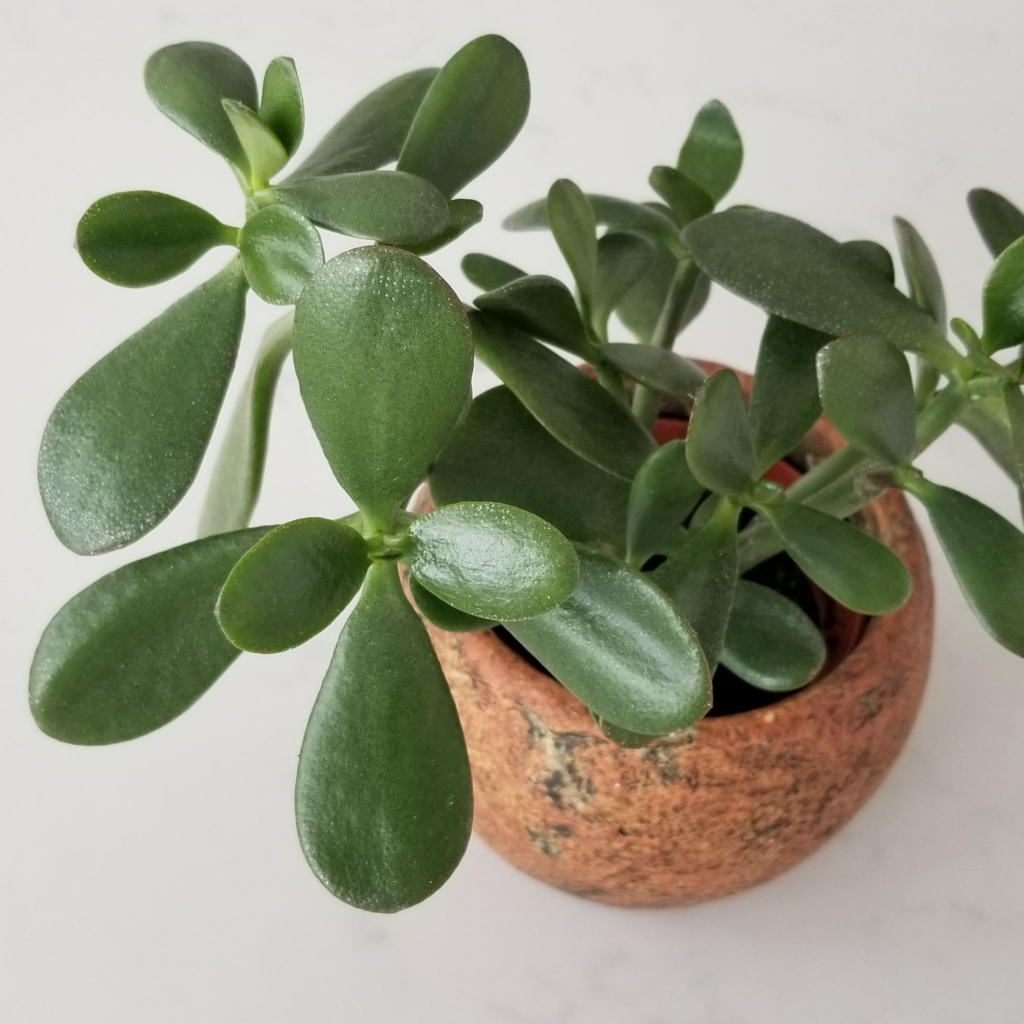
A gorgeous, easy-to-care-for succulent that adds elegance to any space. With its vivid green foliage and hardy character, the Jade Plant is ideal for both novice and seasoned plant enthusiasts. Join us as we look at how to care for this lovely houseplant, its history, and the symbolism it represents. Prepare to welcome a little touch of green magic into your home with the Jade Plant.
| Plant Type | Succulent, perennial |
| Mature Size | 3–6 ft. tall, 2–3 ft. wide |
| Sun Exposure | Full sun |
| Soil Type | Well-drained |
| Soil pH | Neutral, acidic |
| Bloom Time | Spring |
| Flower Color | White |
| Hardiness Zones | 11–12 (USDA) |
| Native Area | Africa |
| Toxicity | Toxic to dogs and cats |
Peace Lilly

Peace lilies are beautiful indoor foliage plants with spectacular white blossoms. Peace lilies are easy to grow, making them a popular houseplant and one of the best air-purifying indoor plants. Peace Lily is a very popular indoor houseplant. It is a clump-forming herbaceous perennial with white flowers that resemble the hood of a cobra. The leaves are bright and glossy, even without spathes.
Peace lilies are strong plants with glossy, dark green oval leaves that taper to a point. The long-lasting blossoms start pale green and gradually turn creamy white as they open. Be warned that calcium oxalate crystals exist in plant cells and, if consumed, can cause poisoning in dogs and children. The most prevalent adverse effect is burning in the mouth, throat, and tongue.
| Plant Type | Perennial |
| Mature Size | 1–4 ft. tall, 1–4 ft. wide (indoors), up to 6 ft. tall (outdoors) |
| Sun Exposure | Partial |
| Soil Type | Moist but well-drained |
| Soil pH | Acidic |
| Bloom Time | Spring |
| Flower Color | White, yellow |
| Hardiness Zones | 11–12 (USDA) |
| Native Area | Central America, Asia |
| Toxicity | Toxic to pets |
Pothos

Pothos, sometimes known as devil’s ivy, golden pothos, or hunter’s rove, is one of the most popular houseplants in North America. Pothos (Epipremnum aureum) is one of the easiest houseplants to care for and a great choice for first-time gardeners. It is a tropical vine endemic to the Solomon Islands of the South Pacific that may be trained to climb support or trail from a pot or hanging basket. Its adaptability and low maintenance requirements make it an excellent choice for any houseplant collection. It is highly effective at removing indoor pollutants like formaldehyde, xylene, and benzene.
| Plant Type | Vine |
| Mature Size | 20–40 ft. long, 3–6 ft. wide |
| Sun Exposure | Full sun, partial shade |
| Soil Type | Moist but well-drained |
| Soil pH | Neutral to slightly acidic |
| Bloom Time | Rarely flowers |
| Flower Color | Gold/Yellow, Purple/Lavender |
| Hardiness Zones | 10–12 (USDA) |
| Native Areas | Asia |
| Toxicity | Toxic to dogs and cats |
Spider Plant

The Spider plant, Chlorophytum comosum, is one of the most popular and widely recognized types of houseplants, despite its unpleasant name. It is extremely popular among beginners due to its ease of growth and propagation, tolerance of neglect, and ability to survive in almost any environment. Its common name comes from the tiny plantlets that are produced on long, trailing stems that resemble tiny spiders. When planted in the right conditions and kept out of the frost, spider plants develop fairly quickly.
| Plant Type | Herbaceous, perennial |
| Mature Size | 1–2 ft. tall and wide |
| Sun Exposure | Partial, shade |
| Soil Type | Loamy, well-drained |
| Soil pH | Neutral |
| Bloom Time | Flowers regularly |
| Flower Color | White |
| Hardiness Zones | 9–11 (USDA) |
| Native Area | Central and Southern Africa |
| Toxicity | No |
Boston Fern

Nephrolepis exaltata, also known as the Boston fern, is a bit of a show-off that will look great in any space thanks to the leaflets that grow on either side of its lance-shaped, light green fronds that can reach a maximum length of 90 cm.
These stunning, green beauties have so much to appreciate. To begin with, their fluffy, luscious green fronds provide your home with a wonderful flash of brilliant, textured green. They not only have a great appearance but also have amazing air-purifying properties and are pet-friendly. One of the greatest indoor plants for air purification is the Boston fern. It aids in the removal of pollutants from indoor air, such as formaldehyde, plastic off-gassing, and cigarette smoke. Additionally, this plant brings moisture back to the dry air, which may aid with dry skin, noses, and throats.
| Plant Type | Herbaceous, perennial |
| Mature Size | 2 to 3 feet tall and wide |
| Sun Exposure | Partial sun |
| Soil Type | Moist, well-drained |
| Soil pH | Acidic (6.0 to 6.5) |
| Bloom Time | Non-flowering |
| Flower Color | Non-flowering |
| Hardiness Zone | 10 to 12 (USDA) |
| Native Area | Americas, Africa, Polynesia |
| Toxicity | Not toxic to pets |
Philodendron

The Philodendron genus is home to hundreds of varieties of stunning foliage plants. Philodendrons are excellent for bringing a little bit of their native tropical flare into your house because of their huge, glossy, green foliage. There are two varieties of philodendrons to select from: vining and non-climbing. These well-liked houseplants are renowned for their simple growth tendencies. The vining types reach heights of many feet, and they typically need a support structure to climb, either a trellis or the area surrounding a basket. Varieties that don’t climb are great container foliage plants since they grow straight. For dogs and cats, every plant in the genus Philodendron is poisonous.
Philodendron plants come in more than 400 different species. They have a wide variety of leaf forms, sizes, and hues, ranging from vivid green heart-shaped leaves to purple lacy foliage. The most widely used indoor types consist of:
- Philodendron hederaceum (Heartleaf philodendron)
- Philodendron brasil (Lemon-lime philodendron)
- Philodendron micans (Velvet-leaved philodendron)
- Philodendron erubescens (Blushing philodendron)
- Philodendron bipennifolium (Horsehead philodendron)
| Plant Type | Perennial |
| Mature Size | 1–20 ft. tall, 1–6 ft. wide |
| Sun Exposure | Partial |
| Soil Type | Loamy, well-drained |
| Soil pH | Acidic |
| Hardiness Zones | 9–11 (USA) |
| Native Area | Central America, South America |
| Toxicity | Toxic to pets, toxic to people |
String of Pearls

The String of Pearls, or Curio Rowleyanus, is a distinctive trailing succulent. The distinctive vine succulents known as “string of pearls” are distinguished by their little, pea-sized leaves. Like a string of rubies succulent, the leaves of planters and hanging baskets grow on trailing stems that cascade gently over their sides. The plant, which is indigenous to Southwest Africa, is distinguished by its trailing stalks that have spherical leaves.
The round beads, which resemble pearl strings, are the source of the name. It’s vital to remember that this gorgeous succulent is poisonous to people and animals alike. Among other symptoms, it can cause severe skin irritation and dermatitis. Keep children and pets away from it.
| Plant Type | Succulent |
| Mature Size | 1-2 ft. tall, 1-2 ft. long |
| Sun Exposure | Full, partial |
| Soil Type | Sandy, well-drained |
| Soil pH | Neutral to acidic |
| Bloom Time | Summer |
| Flower Color | White |
| Hardiness Zones | 9-12 (USDA) |
| Native Area | Africa |
| Toxicity | Toxic to humans, toxic to pets |
Snake Plant

The snake plant, sometimes referred to as mother-in-law’s tongue, is a well-liked and hardy houseplant with leaves that resemble swords. Several types feature leaves with a yellow or white border and green bands or stripes. Dracaena Trifasciata is the scientific name for this specific sansevieria, which is indigenous to both Asia and Africa. Its sword-shaped, evergreen leaves, which grow straight and resemble artificial foliage, are its distinguishing feature.
Although consumed, snake herbs are quite toxic, despite their generally perceived safety. If consumed in excessive amounts, the toxins found in their leaves can result in tongue numbness and swelling. It is advisable to keep children and animals who are prone to nibbling away from this plant.
| Plant Type | Evergreen perennial |
| Mature Size | 2-5 ft. tall when grown as a houseplant |
| Sun Exposure | Sun to part shade |
| Soil Type | Sandy, well-drained |
| Soil pH | Slightly acidic to slightly alkaline |
| Bloom Time | Spring |
| Flower Color | White |
| Hardiness Zones | 9–11 (USDA) |
| Native Area | West Africa |
| Toxicity | Toxic to cats and dogs |
Monstera

Monstera deliciosa, often known as the split-leaf philodendron or Swiss cheese plant, is a tropical plant that is often grown indoors. Their common trait of having naturally occurring leaf holes has earned them the moniker “Switzerland Cheese Plant.”Because of its “wow” factor, this easy-to-grow climbing evergreen is a common sight in designer environments. The glossy, heart-shaped split leaves of Monstera deliciosa create a striking effect. As a result of growing up in a rainforest where overhanging vegetation hides sunlight, monstera leaves have holes in them. The perforations, therefore, are meant to let light reach both the top and bottom of the foliage.
Growing quickly—between one and two feet annually—it takes three years to reach full maturity before you have a monstera. It is doubtful that eating a portion of a Monstera plan will kill a cat or other house pet unless they consume a very large amount. Instead, it may irritate their mouth, throat, and stomach.
| Plant Type | Vine |
| Mature Size | 3-15 ft. tall, 3-8 ft. wide |
| Sun Exposure | Partial |
| Soil Type | Well-drained |
| Soil pH | Acidic, neutral |
| Bloom Time | Summer |
| Flower Color | White |
| Hardiness Zones | 10-12 (USDA) |
| Native Area | Central America |
| Toxicity | Toxic to humans, cats, and dogs |
Prayer Plant

With stunning ornamental leaves, the prayer plant is easily recognizable among other tropical plants. A popular tricolor variety, the leaves are velvety and deep green with yellow splotches down the midrib and red veins that arch to the leaf borders. The term “prayer plant” refers to members of the Maranta genus, which is closely linked to the Calathea genus. Both are regarded as “prayer plants.” This family of plants has a propensity to droop, or “pray,” at night, which is where the term originates. A few of the most widely grown prayer plants are M. leuconeura ‘Tricolor’ and Maranta leuconeura.
The prayer plant is a slow-growing plant that can eventually grow up to one foot within. Though they can be planted and cared for indoors at any time of year, they are quite popular houseplants that are difficult to maintain over time.
Rosmarinic acid, one of the active ingredients in rosemary that gives it its distinctive aroma, is produced by a variety of Maranta species. This plant is safe for pets and won’t harm dogs or cats.
| Plant Type | Herbaceous, perennial |
| Mature Size | 6–12 in. tall, 6–12 in. wide |
| Sun Exposure | Partial, shade |
| Soil Type | Moist but well-drained |
| Soil pH | Neutral, acidic |
| Bloom Time | Spring |
| Flower Color | White |
| Hardiness Zones | 11-12 (USDA) |
| Native Area | South America |
| Toxicity | Not toxic to pets |
Zz Plant
An incredibly fashionable and well-liked houseplant is the ZZ Plant, often known as the Zanzibar Gem. Its striking and distinctive foliage adds eye-catching appeal, and its carefree needs make it an excellent choice for forgetful houseplant owners. Little yet broad, glossy, dark green leaves of Zamioculcas zamiifolia zigzag along tall, slender stems. The plant also can filter the air by eliminating volatile organic pollutants such as xylene, toluene, benzene, and ethylbenzene. Due to its extreme adaptability, this houseplant has gained popularity across the globe in recent years. It requires little water and can withstand low light levels.
It is known for its smooth, naturally glossy leaflets that mature from a bright lime color to an emerald green. Large, water-storing rhizomes that are buried beneath the earth give rise to thick, somewhat bulbous stalks from which individual leaflets, which are normally one to three inches long, emerge. ZZ plants are harmful to people, although not as much as they are to animals. Once more, if the sap of the ZZ plant is inadvertently consumed, it can result in vomiting, diarrhea, and skin irritation. Therefore, when you take care of your ZZ plan, make sure to wear protective gloves.
| Plant Type | Perennial |
| Mature Size | 2-4 ft. tall, 2-4 ft. wide |
| Sun Exposure | Partial |
| Soil Type | Well-draining |
| Soil pH | Neutral, acidic |
| Bloom Time | Spring |
| Flower Color | Yellow, green, white |
| Native Area | Africa |
| Toxicity | Toxic to humans, toxic to pets |
Anthurium
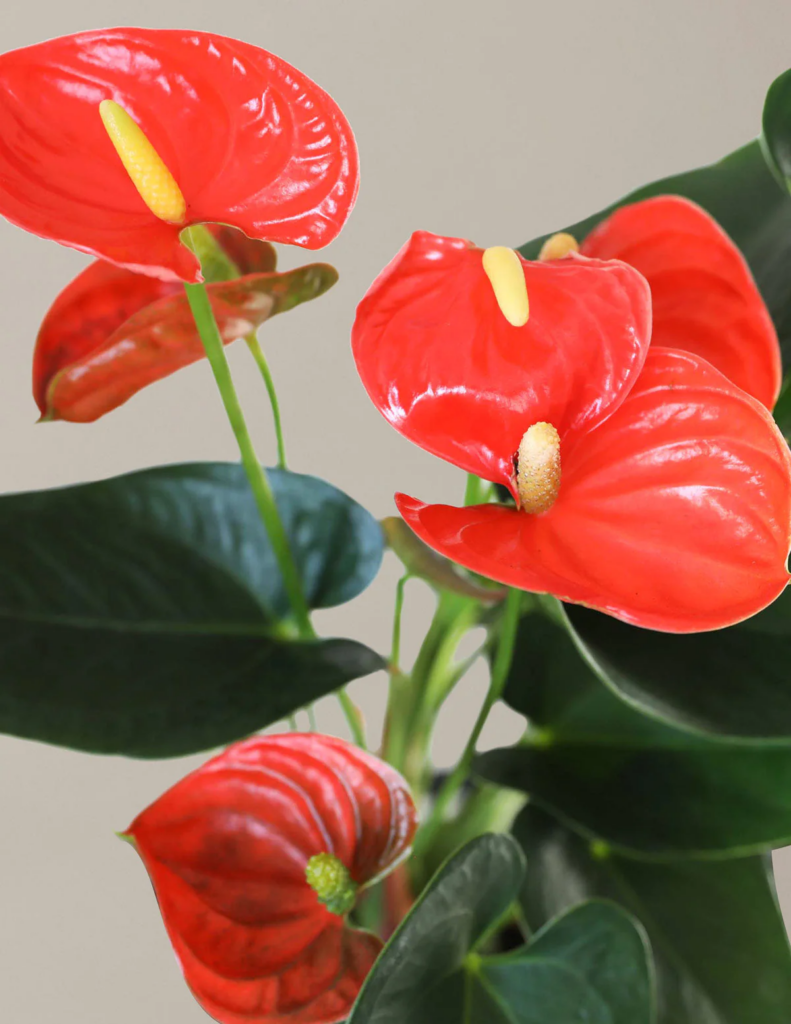
The open heart-shaped blossom of the anthurium evokes abundance and happiness, serving as a sign of hospitality. The fascinating houseplant anthurium is well-known for its colorful leaves and heart-shaped “flowers”. The intriguing houseplant Anthurium, sometimes referred to as Flamingo Flower, Tail Flower, or Painted Tongue Plant, has heart-shaped “flowers” that are colored waxy leaves called spathes. This beginner’s guide to caring for Anthurium will assist you in maintaining the health and beauty of these stunning plants. Because of their striking red, green, and white hues, they are also known as “flamingo flowers” and can bloom for extended periods.
Heart-shaped waxy spathes, or modified leaves around the flower, and red or yellow spikes are characteristic features of blooming variants. Many anthuriums are climbers, and they all require high humidity and warmth to grow. Anthurium is hazardous to both people and pets.
| Plant Type | Herbaceous, perennial |
| Mature Size | 12-18 in. tall, 9- to 12-inch wide |
| Sun Exposure | Partial |
| Soil Type | Well-drained |
| Soil pH | Acidic |
| Bloom Time | Spring, summer, fall, winter |
| Flower Color | Red, pink, white |
| Hardiness Zones | 11-12 (USDA) |
| Native Area | Central America, South America, Caribbean |
| Toxicity | Toxic to humans and pets |
Parlor Palm
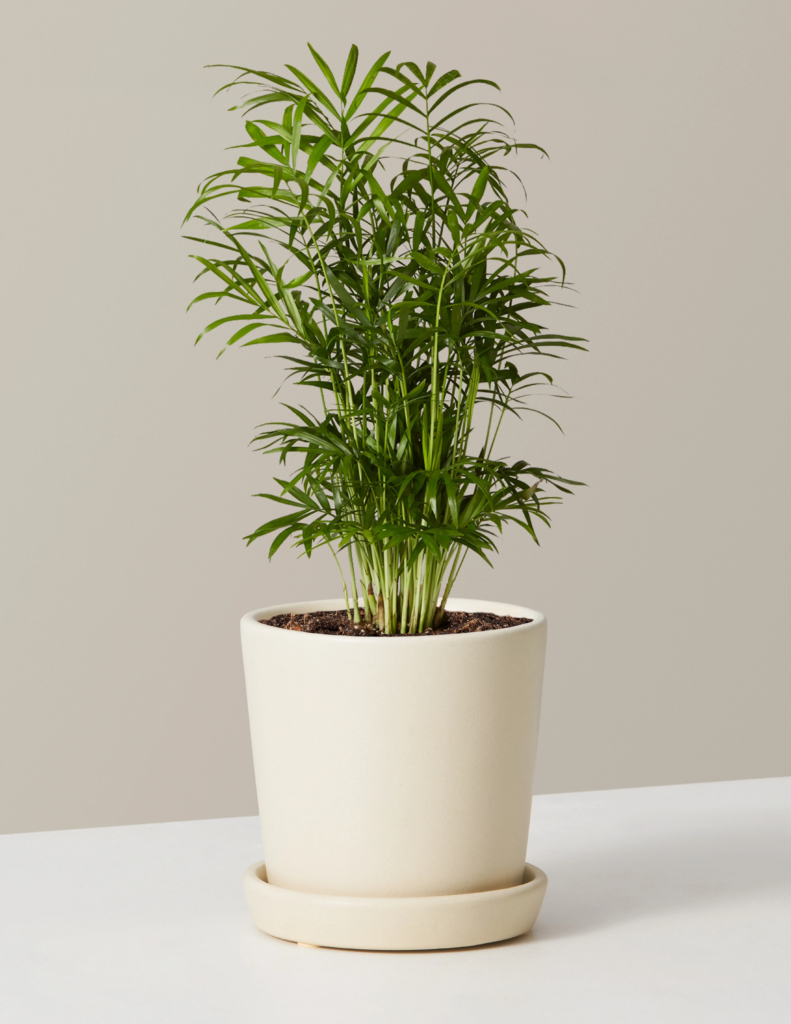
Parlor palm has vivid, luscious tropical fronds. The parlor palm, also known as Chamaedorea elegans, is one of the most suitable palms for novices. Parlor Palm’s delicate, green leaves and easy growth make it an ideal choice for indoor décor.
Parlor palms thrive in tropical or indoor environments with bright, indirect sunlight, well-drained acidic to neutral soil, and temperatures between 65°F and 75°F, however, they may tolerate lower light levels. This gorgeous plant with deep green foliage was discovered in Central America and introduced to the United States, where it quickly became a favorite indoor palm. It forms lovely clumps that conceal the slender trunks beneath the light-textured foliage.
Having a parlor palm in your home helps filter and clean the air, promotes humidity, and adds an appealing touch of green. The Parlor Palm plant is non-toxic to pets like cats and dogs and has air-purifying properties. This makes the Parlor Palm Plant an excellent choice for first-time plant owners and plant enthusiasts.
| Plant Type | Palm |
| Mature Size | As a houseplant, 2-6 ft. tall, 2-3-ft. spread |
| Sun Exposure | Bright, indirect light |
| Soil Type | Use a peaty soil-based potting mix |
| Soil pH | Acidic to neutral |
| Bloom Time | Spring; rarely blooms indoors |
| Flower Color | Yellow |
| Hardiness Zones | 10-12 (USDA) |
| Native Area | Rainforests of southern Mexico and Guatemala |
| Toxicity | Not toxic to pets and human |
Lucky Bamboo

Sculptural lucky bamboo plants include eye-catching designs, swirls, or braided stems and are commonly found in offices and homes to promote positive feng shui. According to these beliefs, it represents good luck and happiness, making it a great and popular gift in both business and personal situations. Another reason why fortunate bamboo is so popular is its ability to be taught into shapes such as swirls, hearts, braids, and other motifs. They can also be trained to produce stalks that are straight as an arrow and ornamented with petite, basic floppy green leaves.
Though the plant resembles bamboo and grows quickly (it may reach a height of more than a foot in six months), it is not related to bamboo and is a succulent plant. If you want to add an exotic touch to your indoor garden or bring good luck into your home, lucky bamboo is a great choice. However, be careful that this plant is poisonous to cats and dogs.
| Plant Type | Perennial shrub |
| Mature Size | 1–5 ft. tall, 1–2 ft. wide (indoors) |
| Sun Exposure | Partial shade |
| Soil Type | Water or moist but well-drained soil |
| Soil pH | Acidic |
| Bloom Time | Fall, winter (does not bloom indoors) |
| Flower Color | White |
| Hardiness Zones | 10–11 (USDA), but typically used indoors |
| Native Area | Africa |
| Toxicity | Toxic to animals |
Sweetheart Plant
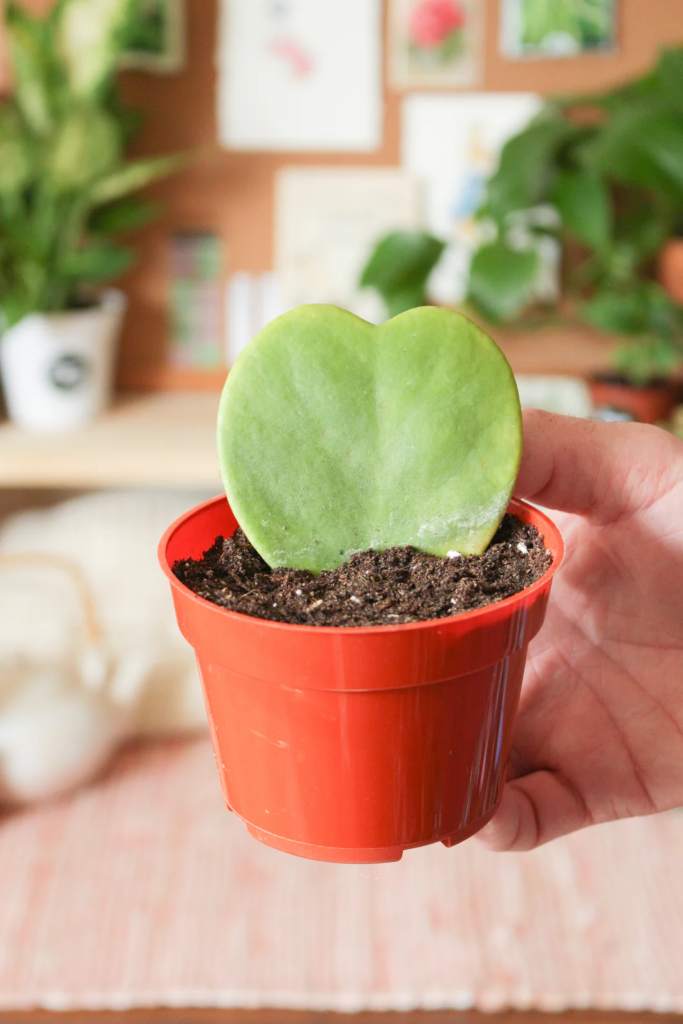
Philodendron scandens is known as the Sweetheart Plant or Heart-Leaf because of its exquisite leaf form. Its apparent connotation with love makes it an appropriate present for weddings, anniversaries, or simply because.
The sweetheart plant is a vining Philodendron that can reach incredible lengths whether supported as a climber or trailing from a hanging basket or shelf. A row of trailing Philodendron scandens creates an excellent living, green curtain. Mature plants may produce spathes of green and white blooms. This lends it the alternate popular name ‘Valentine Hoya’. They’re frequently presented as gifts on Valentine’s Day because they’re said to represent love and devotion.
Sweetheart Plants can gradually expand to form a bushy cluster of miniature green hearts, making them excellent for a hanging basket once they reach maturity. However, they are usually offered as a single leaf planted in a small pot. Hoya kerrii maintenance is simple. These tropical succulents are not only gorgeous, but they also produce trailing woody vines that are wonderfully easy to cultivate, require little maintenance, and grow slowly.
| Plant Type | Vine, succulent |
| Mature Size | 13 ft. long |
| Sun Exposure | Full |
| Soil Type | Well-draining |
| Soil pH | Acidic, neutral |
| Bloom Time | Spring, summer |
| Flower Color | Pink, white |
| Hardiness Zones | 11 (USDA) |
| Native Area | Asia |
| Toxicity | Non-toxic |
Pilea [Chinese Money Plant]

Pilea Peperomioides, popularly known as the Chinese Money Plant, is a stunning green plant that has become one of the world’s most popular. This plant is a member of the stinging nettle family and is extremely easy to maintain. This wonderful little plant is quite beautiful. With its rounded dark green leaves, it is ideal for adding interest to your indoor jungle. It is cultivated largely for its distinctive foliage. Although Pilea peperomioides can produce small, white flowers throughout the spring, they rarely bloom when cultivated inside.
Along with these wonderful names, this houseplant is also known as the Mirror Grass Plant, UFO Plant, Pancake Plant, Lefse Plant, Missionary Plant, Bender Plant, and Pass-it-on Plant.
It was once thought to bring good luck, money, and fortune to its owner. The huge, spherical leaves resemble coins due to their stacking on top of one another. Although money doesn’t grow on trees, it’s still worthwhile to spend some time with the Coin Plant.
| Plant Type | Perennial |
| Mature Size | 12 in tall, 8 to 12 in. wide |
| Sun Exposure | Partial |
| Soil Type | Well-draining |
| Soil pH | Acidic, neutral |
| Bloom Time | Spring |
| Flower Color | White |
| Native Area | China |
| Toxicity | Non-toxic |
Watermelon peperomia

Watermelon peperomia (Peperomia argyreia) has gained appeal among houseplant enthusiasts because of its gorgeous watermelon-patterned foliage. It’s nicknamed the “Watermelon Peperomia” because its leaves resemble small watermelons. They have a compact growth pattern, and their leaves are not only multicolored but also shiny, making them exceptionally beautiful when exposed to sunshine. Watermelon peperomia, a tropical plant native to South America, grows naturally in the rainforest understory and thrives indoors. Watermelon peperomia, possibly the most popular form of peperomia, is an excellent tropical species for beginners.
They adapt nicely to simple care commitments, providing a little but brilliant splash of color. Watermelon Peperomia is ideal for arranging on your shelf, kitchen island, or desk to create a stunning focal point. Spend five minutes trimming and spraying your plant to add some zen and tranquility to your day whenever you need a little pick-me-up.
The air surrounding you is also made cleaner by this lovely houseplant. NASA research indicates that Peperomias can cut airborne formaldehyde by 47 percent. A clean-air plant is a good addition to any home office as it can enhance productivity and concentration.
| Plant Type | Perennial |
| Mature Size | 12 in. tall, 8 in. wide |
| Sun Exposure | Partial |
| Soil Type | Moist but well-drained |
| Soil pH | Acidic |
| Bloom Time | Spring, summer |
| Flower Color | Green |
| Hardiness Zones | 10a, 10b, 11a, 11b, 12a, 12b |
| Native Area | South America |
| Toxicity | Non-toxic |
Aglaonema
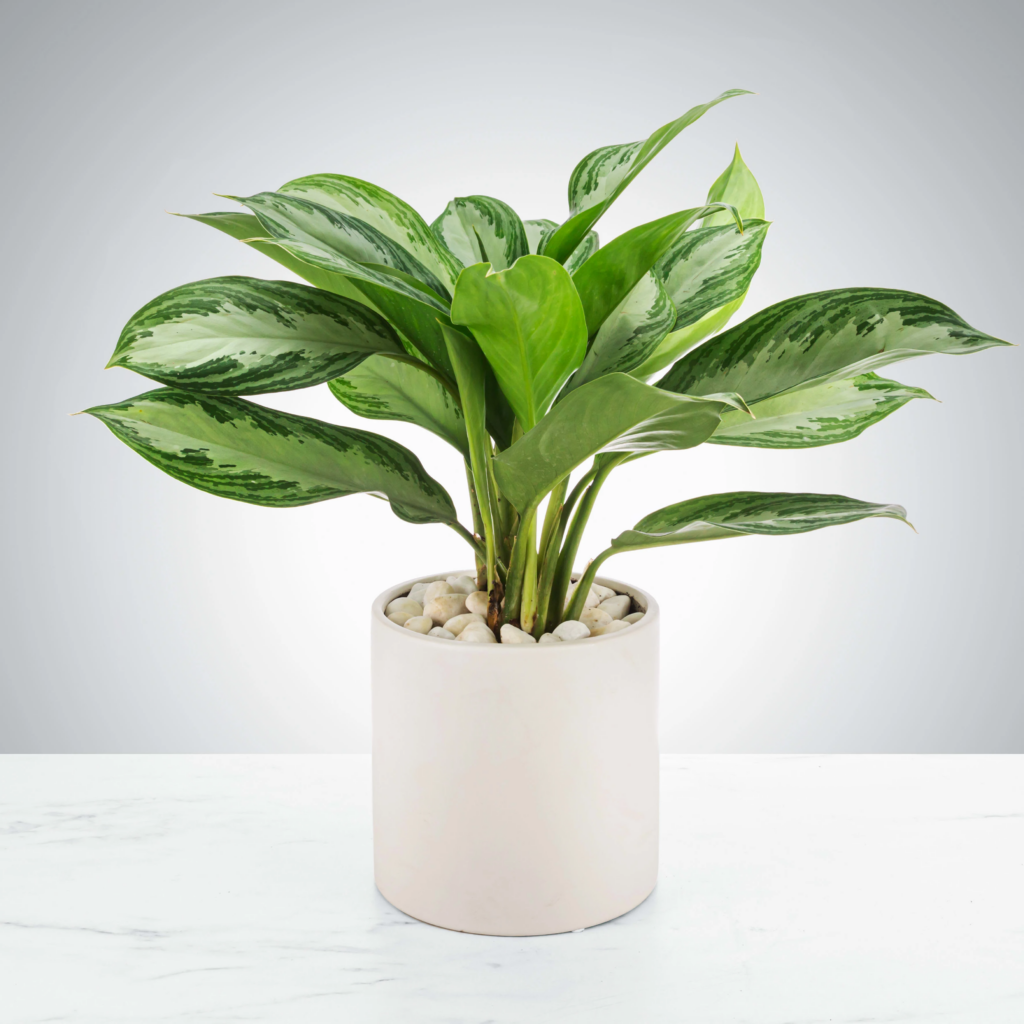
The popular indoor plant Aglaonema sometimes referred to as the Chinese Evergreen, is native to Asia’s tropical and subtropical areas. It belongs to the Araceae family and is distinguished by its eye-catching leaf, which comes in a variety of sizes, shapes, and colors. The plant is also referred to as the “luck plant” since it is associated in Chinese culture with good fortune. These plants give a stunning appeal to homes and offices with their intriguing blend of dark green foliage enhanced with a captivating green pattern and cream variegation.
Aglaonema is a visually appealing genus for those who enjoy houseplants because of its spectacular hue and patterns, which are further enhanced by the pronounced veins on the foliage.
Aglaonema plants are well known for being able to adapt to a wide range of environments, flourishing in both high and low light. With their ability to thrive in low light conditions, these low-maintenance houseplants are ideal for homes and businesses with indirect lighting.
For those looking to bring a little bit of nature into their living areas, the Aglaonema plant is the ideal choice due to its captivating beauty and low maintenance requirements.. Aglaonema plants come in a variety of varieties, each with special qualities of its own. Among the most popular varieties are the Maria, Red Emerald, and Silver Bay. Chinese evergreens are popular indoor foliage plants that look good in pots and require little care throughout the year because of their sluggish growth. Dogs and cats should not consume the plant.
| Plant Type | Herbaceous, perennial |
| Mature Size | 1–3 ft. tall, 1–3 ft. wide |
| Sun Exposure | Partial, full |
| Soil Type | Well-drained |
| Soil pH | Acidic |
| Bloom Time | Spring, summer |
| Flower Color | White |
| Hardiness Zones | 10–12 (USDA) |
| Native Area | Asia |
| Toxicity | Toxic to dogs and cats |
Air Plant
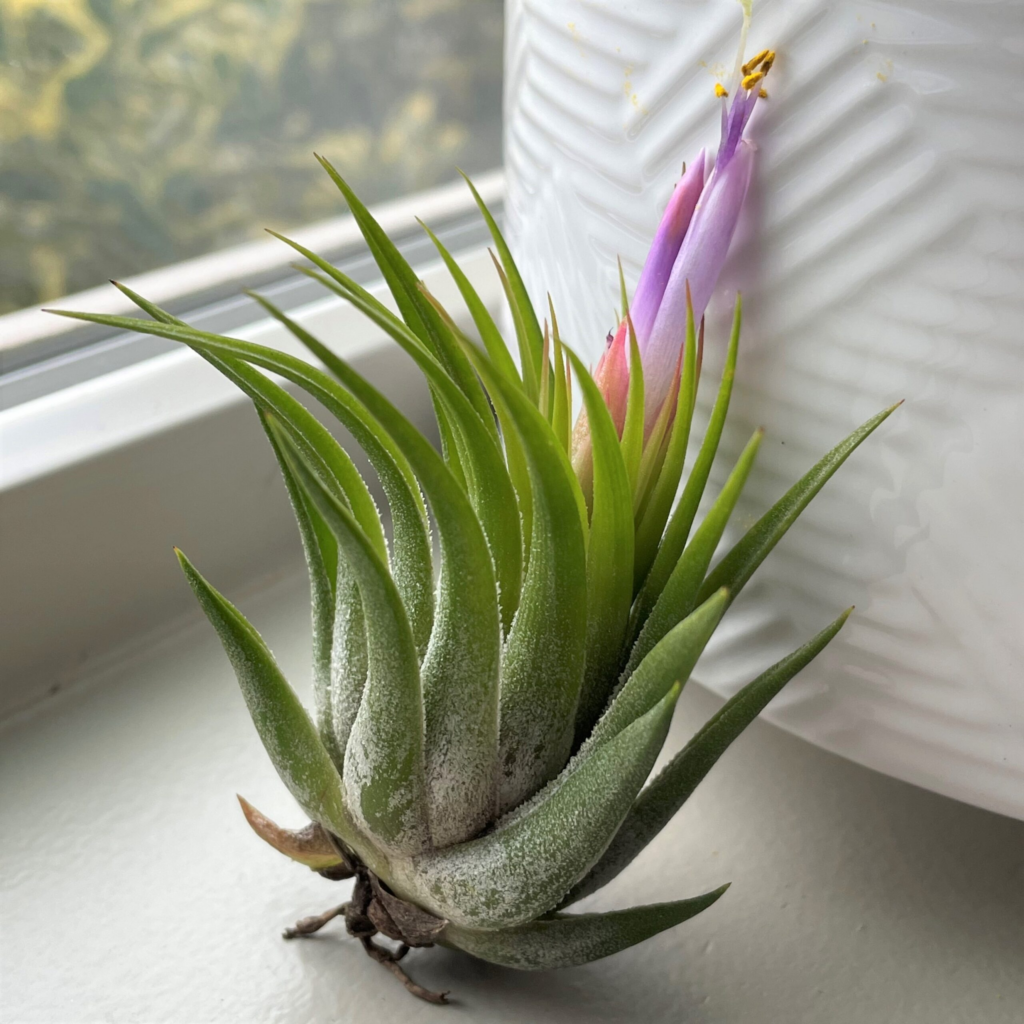
Consider an air plant if you want to start cultivating indoor plants or if you want to add something different to your collection. Indoor air plants can be easy and rewarding for novices because they don’t need soil to grow; they are also renowned for being low-maintenance and entertaining to arrange for your house. As epiphytes, air plants (Tillandsia spp.) develop on other plants in the natural world, mainly on the branches of trees. Air plants come in hundreds of types and varieties. Typically, they feature lance- or strap-shaped, narrow leaves that grow in a rosette formation, with new growth emerging from the center. Silver-leafed varieties are generally the most drought-tolerant, while greener varieties dry up more quickly.
Additionally, there are species with vibrant foliage that have coral leaves, such as Tillandsia maxima. The majority of species also have lovely funnel- or tubular-shaped blooms. The majority of Tillandsia species are 2 to 12 inches tall when houseplants, but they can grow up to 7 feet tall in their natural tropical habitats.
Air plants flourish in the absence of soil. This implies that they can be cultivated indoors in almost any place where there is bright indirect light. Grow them in terrariums, put them in trays or specialty hangers, or arrange them in glass globes, dishes, vases, or seashells. Often, the only thing stopping someone’s creative display of them in the house is their imagination!
| Plant Type | Epiphytes |
| Mature Size | Indoors: 2-12 in. tall, Outdoors: 5-7 ft. |
| Sun Exposure | Partial |
| Bloom Time | Dependent on type |
| Flower Color | Red, pink, blue, purple, yellow, white |
| Hardiness Zones | 9-13 (USDA) |
| Native Areas | North America, South America |
| Toxicity | Non-toxic |
Conclusion
Choosing the ideal plants for your environment depends primarily on the climate where you live. Any plant can flourish under your loving care and attention with the right amount of maintenance, turning your area into a lush haven. You may create a beautifully flourishing green sanctuary by following a few easy recommendations.
Accept the particular requirements of your area’s climate, since it is essential to successful gardening projects. Knowing your environment is crucial, regardless of whether you live in the warm tropical climate or the more temperate embrace of more moderate zones.
Every plant needs a certain kind of care, much like a beloved friend. By being patient and paying close attention, you can discover the keys to fostering their development. From supplying the ideal quantity of sunlight to guaranteeing.
Let the pulse of life in your plants be your reward, and let the rhythm of the seasons serve as your motivation. May your green oasis grow with every day, proving the beneficial relationship between grower and plant.
Video on Best 20 Easy-Going Indoor Plants
References
- https://www.midwestliving.com/garden/container/super-easy-house-plants/
- https://www.housebeautiful.com/lifestyle/gardening/g2495/indoor-plants/
- https://www.garde nersdream.co.uk/blog/2022/11/14/the-top-20-best-indoor-house-plants-to-grow-at-home/#20_Cacti_Succulents
- https://www.goodhousekeeping.com/home/gardening/g19682442/aloe-plant-care/
- https://www.thespruce.com/

